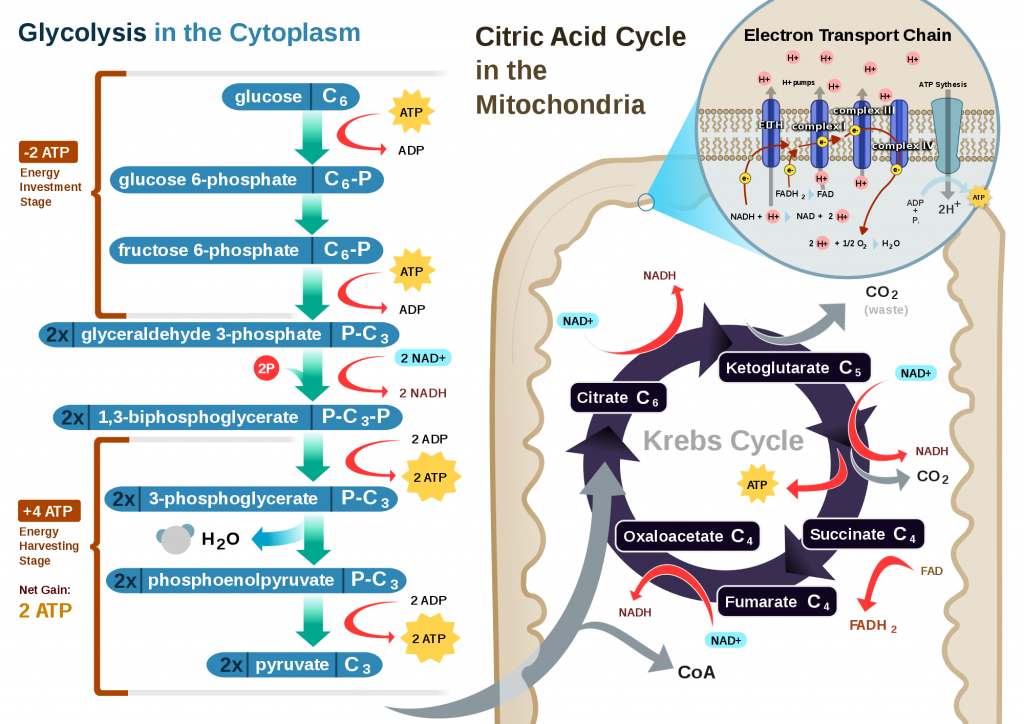Contents
Respiration
Respiration
Respiration is the reaction that produces the ATP needed for other metabolic reactions in cells. It is an enzyme-controlled reaction and is therefore sensitive to temperature and pH changes.
Glucose is broken down to release ATP, but if there is no glucose, glycogen (in animals) or starch (in plants) stores of glucose left, then other respiratory substrates are used. Lipids can be hydrolyzed to glycerol and fatty acids. The glycerol is then phosphorylated into triose phosphate and enters aerobic respiration at the Krebs cycle. Proteins could also be modified and used. Amino acids must be hydrolyzed and the amino group removed (deamination). The carbon compound that remains can enter the Krebs cycle.
Aerobic Respiration
Aerobic respiration is split into four stages:
- Glycolysis (cytoplasm)
- Link reaction (Mitochondrial matrix)
- Krebs cycle (Mitochondrial matrix)
- Oxidative Phosphorylation (Cristae)
Glycolysis
Glycolysis is the first stage and as it does not require oxygen and occurs in the cytoplasm, it is part of both anaerobic and aerobic respiration. Glycolysis (sugar splitting) involves three key stages:
- Substrate-level phosphorylation - The glucose has two phosphate groups added to it from two ATP molecules.
- Phosphorylation makes the glucose-2-phosphate unstable and it splits into two 3-carbon compounds, triose phosphate (TP).
- The two TP molecules are both oxidized to form two pyruvate molecules by removing a hydrogen from each. The hydrogen is picked up by two NAD molecules to become NADH. This process also releases 4 ATP.
Therefore, glycolysis results in the production of 2 NADH, 2 pyruvate, and a net gain of 2 ATP. The NADH and pyruvate are both needed for subsequent stages in aerobic respiration and are therefore actively transported into the mitochondrial matrix.
Link Reaction
This reaction occurs in the mitochondrial matrix and converts pyruvate into acetyl CoA.
Pyruvate contains 3 carbons whereas acetyl CoA contains two, so a carbon is removed in this stage in the form of carbon dioxide. This is known as decarboxylation and requires decarboxylase enzymes. 2 hydrogen atoms are also removed to oxidize the carbon compound further to create acetate. This is known as dehydrogenation and is catalyzed by dehydrogenase enzymes. The NAD picks up the hydrogen to become NADH. The coenzyme CoA combines with the acetate that is formed to create acetyl CoA, this is to assist in acetyl reacting in the Krebs cycle.
The reaction occurs twice per glucose molecule as there are two pyruvate molecules.
The overall products from the link reaction per glucose molecule are:
- 2 x Acetyl CoA
- 2 CO2
- 2 reduced NAD
Krebs Cycle
The acetyl CoA reacts with a four-carbon molecule, releasing coenzyme A and producing a six-carbon molecule that enters the Krebs cycle. In a series of oxidation-reduction reactions, the Krebs cycle generates 8 reduced coenzymes, 2 ATP by substrate-level phosphorylation, and 4 carbon dioxide are lost. In total, therefore, per glucose molecule, 2 ATP, 6 NADH, and 2 FADH are produced. The Krebs cycle is also known as the citric acid cycle.
Oxidation Phosphorylation
This is the final stage of aerobic respiration where most ATP is synthesized and oxygen is used. This stage involves the transfer of electrons down the electron transfer chain and the movement of protons across the inner mitochondrial membranes. The movement of these protons is down a concentration gradient catalyzed by ATP synthase, embedded in these membranes - this is another example of chemiosmotic theory.
In this stage, all of the accumulated reduced coenzymes release the hydrogens, and these split into protons (H+) and electrons (e-). The e- are passed down a series of electron carrier proteins embedded in the inner mitochondrial membrane, losing energy as they move (electron transport chain). The small amount of energy the electrons release pumps protons from the mitochondrial matrix into the intermembrane space. This creates an electrochemical gradient across the membrane. Therefore, the protons move down the electrochemical gradient back into the matrix via ATP synthase, making ATP. This movement of H+ is known as Chemiosmosis. Oxygen is the final electron acceptor in the electron transport chain. The oxygen combines with the electrons and the protons to form water.
Anaerobic Respiration
In the absence of oxygen, respiration occurs anaerobically. The pyruvate produced in glycolysis is reduced to form ethanol (in plants and microbes) or lactate (in animals) by gaining the hydrogen from reduced NAD. This oxidizes NAD so that it can be reused in glycolysis and ensure more ATP is continued to be produced.
Efficiency
1 reduced NAD can result in a yield of 3 ATP molecules, whereas 1 reduced FAD can result in a yield of 2 ATP molecules. Therefore, the total yield of ATP from one glucose molecule should be 38 molecules of ATP. Aerobic respiration is approximately 32% efficient. This is due to some protons leaking across the mitochondrial membrane during oxidative phosphorylation, ATP being used to actively transport pyruvate and NADH into the matrix, and because some energy is lost as heat.
Anaerobic respiration is even less efficient because only 2 ATP molecules are produced from one glucose molecule.
- How many carbons does glucose have?
- 6
- Where does glycolysis take place?
- Cytoplasm
- Why are the glycolysis reactions described as anaerobic?
- Your answer should include: require / no / oxygen
- Where does the Krebs cycle take place?
- Your answer should include: Mitochondrial / matrix
- How many carbons does the intermediate that reacts with acetyl CoA have?
- 4
- How many carbon dioxides are lost per turn of the Krebs cycle?
- 2
- Why must oxidative phosphorylation occur for the Krebs cycle to continue?
- Your answer should include: NADH / to / NAD
- What is the final electron and hydrogen acceptor in oxidative phosphorylation?
- Oxygen







